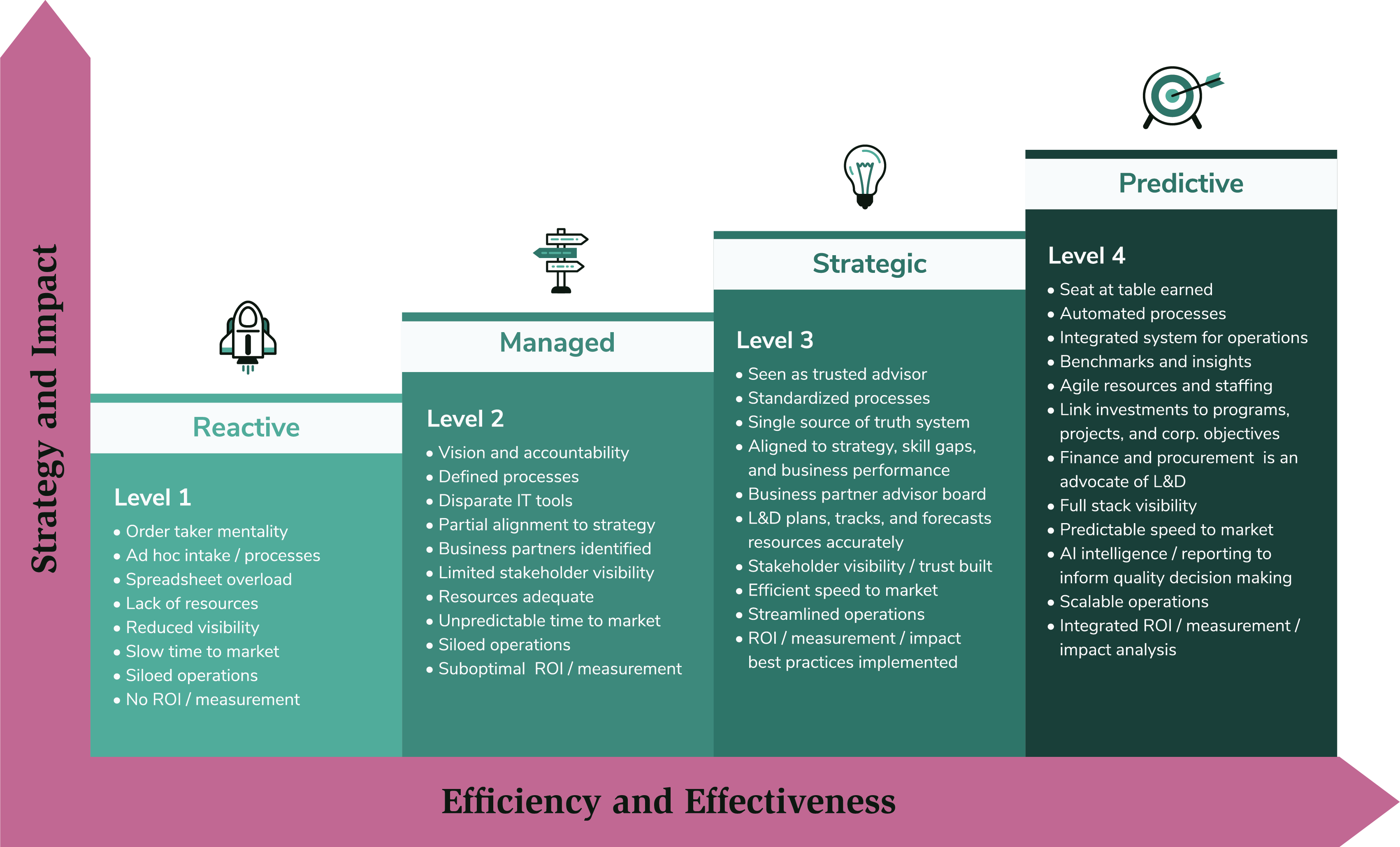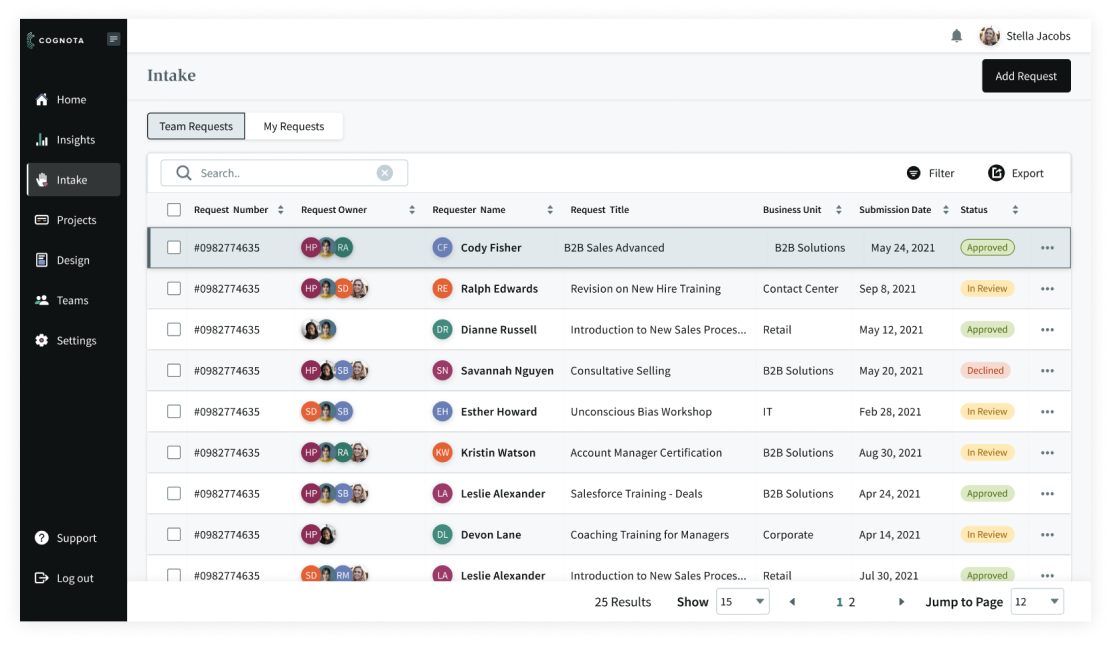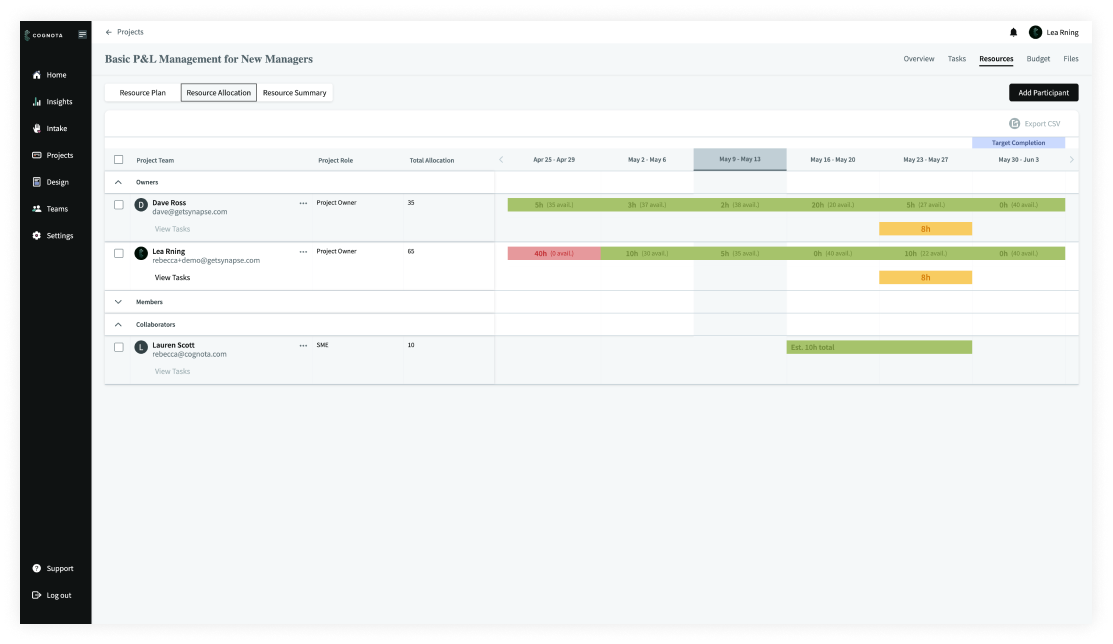Unlock your L&D team’s full potential with a new approach to learning operations, or LearnOps®.

The outlook is bright for today’s L&D teams. The function is experiencing bigger budgets and greater buy-in from the highest levels of the organization than ever before. With that has come increased interaction with business partners and the opportunity to create learning interventions that impact the bottom line.
But with a higher strategic profile in the organization comes greater pressure to deliver results. So, L&D leaders are turning their attention to the operational efficiency of their functions to ensure they can deliver high-quality learning experiences at a faster pace.
There’s no doubt that the opportunity to move from cost center to performance driver presents many challenges for learning and development teams. Data is needed to improve learning measurement and tie outcomes back to business performance. The technology stack must support efficiency rather than causing further silos in collaboration and communication. Processes need to flow smoothly and result in seamless workflows and hand-off between team members. Resources must be leveraged to their fullest potential.
So, how can L&D unlock their full potential?
That’s where LearnOps® comes in.
The outlook is bright for today’s L&D teams. The function is experiencing bigger budgets and greater buy-in from the highest levels of the organization than ever before. With that has come increased interaction with business partners and the opportunity to create learning interventions that impact the bottom line.
But with a higher strategic profile in the organization comes greater pressure to deliver results. So, L&D leaders are turning their attention to the operational efficiency of their functions to ensure they can deliver high-quality learning experiences at a faster pace.
There’s no doubt that the opportunity to move from cost center to performance driver presents many challenges for learning and development teams. Data is needed to improve learning measurement and tie outcomes back to business performance. The technology stack must support efficiency rather than causing further silos in collaboration and communication. Processes need to flow smoothly and result in seamless workflows and hand-off between team members. Resources must be leveraged to their fullest potential.
So, how can L&D unlock their full potential?
That’s where LearnOps® comes in.

Training teams need to produce better learning experiences that support business performance at a faster pace. But what do L&D teams say is holding them back?
It’s clear L&D teams know there are elements holding them back from producing better training at a faster rate. But the root cause behind the barriers listed above really comes down to how learning operations are structured, implemented, and monitored.
So, what are the operational gaps facing L&D that result in limited resources, scope creep, and more?
What do L&D Professionals Say is the Top Barrier to Faster Training Production? *
* According to research published by the Association for Talent Development
Silos and inefficiencies in these areas are causing time, budget, and resources to flow through leaky L&D processes and disparate technologies. By taking a new approach to their structure, processes, workflows, data, and technology, learning teams can address these inefficiencies and create an operational framework that ensures L&D is fully aligned with the business.

Time and cost savings across all L&D processes can increase the team’s ability to work faster and better. Learning professionals often focus on the development and design of learning, but there are other processes that lack efficiency or, in some cases, are not clearly defined in the learning organization, such as training intake, project planning and tracking, resource management, and more.
Clear oversight into your team’s capacity and the availability of resources is critical to answering the demand for training and prioritizing high-impact learning interventions. Launching a training program or taking on new projects without proper capacity planning often results in missed deadlines, an overworked team, and less effective training solutions for
your learners.


Many L&D teams continue to rely on email, spreadsheets, shared files, and generic tools to manage and run their operations. This leaves team members struggling to collaborate efficiently. Important tasks and documentation slip through the cracks, work is often duplicated, and hours are wasted moving from one tool to another throughout the learning lifecycle.
When you get buy-in from senior management within the organization, it’s imperative that you can prove the results of learning investments. without the data and processes to connect learning initiatives to business outcomes, L&D continue to find it challenging to validate their contribution.


Regardless of how you achieve it, business alignment is critical to a successful L&D plan. Without it, L&D are left to take last-minute training requests from the business. Or, other departments take training into their own hands without guidance from the team that knows best when it comes to learning interventions.
Operational gaps facing L&D
Silos and inefficiencies in these areas are causing time, budget, and resources to flow through leaky L&D processes and disparate technologies. By taking a new approach to their structure, processes, workflows, data, and technology, learning teams can address these inefficiencies and create an operational framework that ensures L&D is fully aligned with the business.
Time and cost savings across all L&D processes can increase the team’s ability to work faster and better. Learning professionals often focus on the development and design of learning, but there are other processes that lack efficiency or, in some cases, are not clearly defined in the learning organization, such as training intake, project planning and tracking, resource management, and more.

Clear oversight into your team’s capacity and the availability of resources is critical to answering the demand for training and prioritizing high-impact learning interventions. Launching a training program or taking on new projects without proper capacity planning often results in missed deadlines, an overworked team, and less effective training solutions for
your learners.

Many L&D teams continue to rely on email, spreadsheets, shared files, and generic tools to manage and run their operations. This leaves team members struggling to collaborate efficiently. Important tasks and documentation slip through the cracks, work is often duplicated, and hours are wasted moving from one tool to another throughout the learning lifecycle.

When you get buy-in from senior management within the organization, it’s imperative that you can prove the results of learning investments. without the data and processes to connect learning initiatives to business outcomes, L&D continue to find it challenging to validate their contribution.

Regardless of how you achieve it, business alignment is critical to a successful L&D plan. Without it, L&D are left to take last-minute training requests form the business. Or, other departments take training into their own hands without guidance from the team that knows best when it comes to learning interventions.

LearnOps® is a philosophy and framework for creating efficient Learning Operations. It enables better alignment with the business, clear oversight into the L&D team’s workload and capacity, data-driven planning and decision making, and maximization of L&D resources.
By taking a Learning Operations approach to the way your L&D department is run, you can speed up training creation, expand your team’s capacity, and create value throughout the entire learning lifecycle.
LearnOps® improves outcomes for the L&D department across multiple processes and touchpoints with the business.
By focusing on learning operations, including people, structures, processes, and technology, L&D can ensure they’re positioned to respond to demand, place their resources in the right place at the right time, and ensure learning outcomes are aligned with business success.
Applying a LearnOps® philosophy to your operations requires the right technology to fuel your operational efficiency. With a platform created specifically for L&D operations, you can:
Standardize processes and keep everything from intake, project management, course collaboration, and department insights in one place. Streamline collaboration and day-to-day workflows for your training team and stakeholders.
Closely collaborate with stakeholders and clearly align your L&D team with business performance objectives. Leverage operations data to prioritize high-impact learning interventions that will improve business KPIs.
Increase your team’s productivity through clear oversight into their current and future workload. Maximize resources by delivering them to the right place at the right time.

The First & Only LearnOps® Platform
Want to see how a LearnOps® approach can be implemented? See Cognota up close with a free trial or a personalized demo.

| Cookie | Duration | Description |
|---|---|---|
| cookielawinfo-checbox-analytics | 11 months | This cookie is set by GDPR Cookie Consent plugin. The cookie is used to store the user consent for the cookies in the category "Analytics". |
| cookielawinfo-checbox-functional | 11 months | The cookie is set by GDPR cookie consent to record the user consent for the cookies in the category "Functional". |
| cookielawinfo-checbox-others | 11 months | This cookie is set by GDPR Cookie Consent plugin. The cookie is used to store the user consent for the cookies in the category "Other. |
| cookielawinfo-checkbox-necessary | 11 months | This cookie is set by GDPR Cookie Consent plugin. The cookies is used to store the user consent for the cookies in the category "Necessary". |
| cookielawinfo-checkbox-performance | 11 months | This cookie is set by GDPR Cookie Consent plugin. The cookie is used to store the user consent for the cookies in the category "Performance". |
| viewed_cookie_policy | 11 months | The cookie is set by the GDPR Cookie Consent plugin and is used to store whether or not user has consented to the use of cookies. It does not store any personal data. |